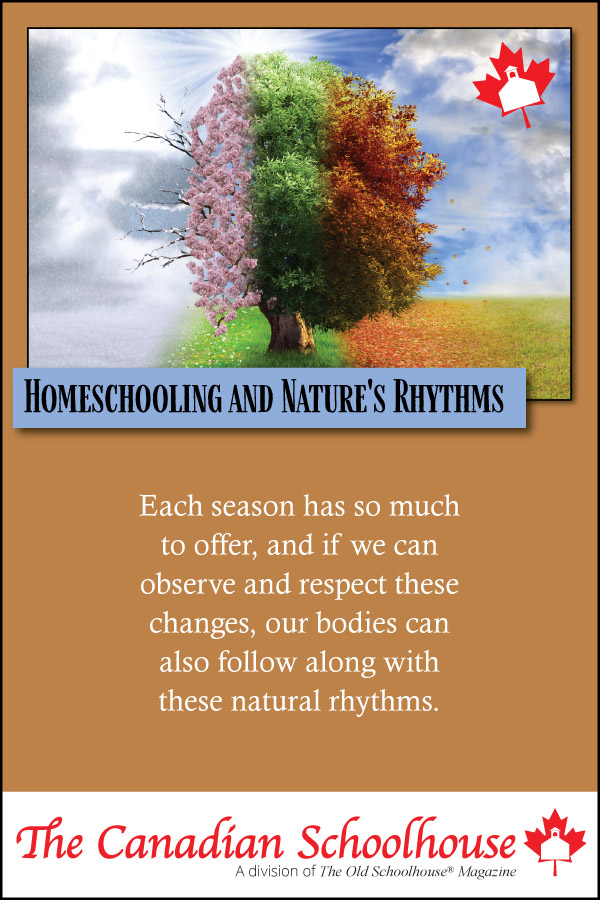

With spring right around the corner, our bodies seem to naturally radiate with anticipation of warmer days and new life emerging. Soon, the days will be longer and busier and seem to turn into a blur of activities as we suddenly feel inspired to do everything at once.
Winter climates can be challenging. Long cold winters with dreary days seem to go on without end, but if we look to the shift in nature around us during each change in season, we can learn how to make the most of these natural rhythms. Since my family started homeschooling 3 years ago and as I began engaging in nature walks and studies with my children, I find myself suddenly aware of the world around us. I feel that each season has so much to offer, and if we can observe and respect these changes, our bodies can also follow along with these natural rhythms.
The hardest season to endure is winter, if you are in such a climate. We spend all summer and fall gathering and preparing so that come the cold days we can relax in front of the woodstove and enjoy a hot cup of coffee and a good book. As we notice outside, nature has shed its beautiful colors and leaves, the days are shorter and darker, and the cold creeps in. Some species of animals have left us for warmer climates, and perhaps we too wish we could escape. But everything was created with divine purpose. There are six months of spring and summer to flourish and six months of fall and winter to rest and rejuvenate. We can embrace these winter months to also slow down, enjoy more quality family time, and rest to be restored for summer.
Our homeschool life has adjusted to match the rhythms of the seasons. Over winter, we tend to sleep in longer and not be too worried about schedules. We incorporate more story time in the evenings, which we like to call ‘cocoa nights,’ where we get all cuddled in together with hot chocolate, cozy blankets, and a captivating book. If there is a topic of interest my kids want to explore, we can take a pause in our regular studies and dive into it. We have done this through watching documentaries, trying experiments, devoting more time to reading, and crafting. Sometimes, it helps to take a break from routine and let our children’s minds wander; then they almost seem to forget they are learning. We also love spending time outside, cold or not.
This winter we made a fort outside, and it has been a little ‘home away from home’ for my children. They have also enjoyed ice fishing, and their skating skills are improving. In winter, we study the patterns of migration with birds such as the Canadian geese, swans, pelicans, and robins and document when they leave and when we first notice them back. We study hibernation, observing when the bears and beavers seek refuge in their dens and when they first emerge. We have also been surprised at what happens to frogs, bugs, and worms over winter. Nature has slowed down, and if we allow ourselves to as well, we begin to notice these changes around us that we otherwise take for granted. And new life has been forming in the wombs of wild game and farm animals, awaiting a new rhythm of spring.

The elements of the four seasons can also apply to each subject and can be a way to appreciate our surroundings. Just as we study our language, we can listen to the language of animals and how they communicate. We can notice shapes and patterns in life everywhere the same as we learn in math and notice there are no mistakes in creation, such as the intricate pattern of the spider web, bees creating precise hexagonal chambers, and snails having spiral shells.
The migration of various species can be followed on maps and is a great way to learn about countries and continents. Science of nature is endless, with everything from weather to life cycles to microscopic life that we cannot even see. Nature’s color palette is magnificent and changes with each season, giving us an array of vibrant sunsets, colourful flowers, and even the whitest of snow, which can inspire every level of painter and artist.
As winter is fading out, we will change our rhythm to fill longer days of sunlight and more time enjoyed outside. Soon we will be planning our garden and looking forward to campfires and swimming at the river. I find homeschooling my children year round works out best for them. It helps them retain what they have been studying, and it provides steady structure. This format also allows us flexibility, and my children don’t feel pressured by deadlines.
We can teach our children not only from books and curriculums but from showing them the world around us. It is amazing how much knowledge they can retain from a simple nature walk, an afternoon at the river, or a day on the farm collecting eggs and helping in the garden. Even as adults, we never stop learning, and we set the examples for our children’s future. We can show them the value of their studies and that learning can be exciting and refreshing.
 Written by Sandy Knudson
Written by Sandy Knudson
I am a homeschooling mother of two children from Alberta. We are currently full time RVers living a minimalist lifestyle. I keep busy with books and hobbies, mainly woodworking and pyrography, which I have been doing for a few years now. I enjoy a faith inspired life and look forward to what new inspirations the Lord has in store.














